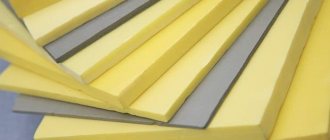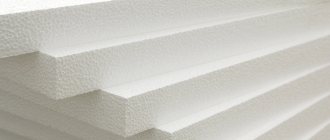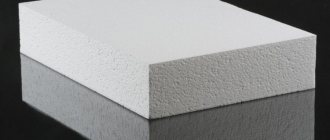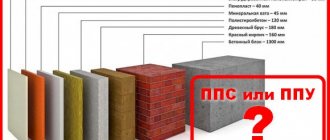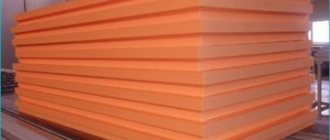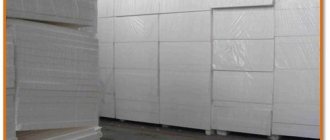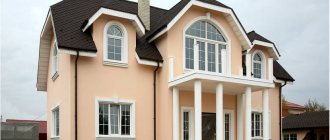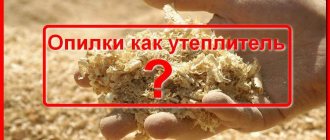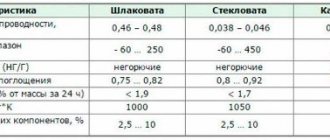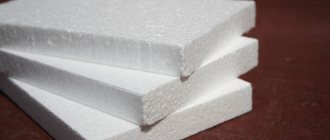The need for wall insulation (if insulation is not part of the construction process) is caused by the insufficient thickness of the building material.
The main reasons for this are: design errors and the desire to save money on the purchase of building materials with the expectation of insulation.
One way or another, insulation is a fairly simple process that can be accomplished with independent efforts; the main thing is to understand the meaning of the actions and take all measures to achieve the most effective result.
The list of popular insulation materials is quite large and is constantly being updated with new materials, but the cheapest, easiest to use and preferred is polystyrene foam.
What is expanded polystyrene
Expanded polystyrene (EPS) is a material consisting of a mass of gas-filled sealed granules soldered into a single conglomerate during the manufacturing process. In this case, the granules themselves are not destroyed, but are only glued together by their walls.
Depending on the initial size of the granules and the temperature during manufacturing, EPS has different densities and hardness. The finer the grains, the denser the structure and stronger the material. The most important physical property of EPS is its extremely low thermal conductivity : a layer of EPS with a thickness of 3 cm is equal in thermal resistance to a layer of concrete with a thickness of 123 cm.
The following types of expanded polystyrene exist:
- PS. Press.
- PSB. Pressless.
- EPPS. Extruded.
- PSB S. Pressless suspension.
In addition, there are subtypes of material that have a special purpose, for example PSB-S 25F - façade expanded polystyrene with a density of 25.
Material Specifications
The density of the material has a fairly wide range of values depending on the brand.
Samples available with densities:
- PSB-S 15.
- PSB-S 25.
- PSB-S 35.
- PSB-S50, where the last digits are the value in kg/cub.m.
Advantages:
- An excellent heat insulator.
- Effective sound insulator.
- The light weight of the material allows for widespread use.
- Self-extinguishing material (free burning time - 3 seconds).
- It is practically impenetrable to steam and moisture, depending on the density (there is a slight absorption of moisture through capillaries - micro-gaps between welded granules).
- Low price.
Flaws:
- Low plasticity; when deformed, the material crumbles or breaks.
- It does not tolerate contact with solvents such as gasoline, acetone, etc.
- When exposed to flame, it emits large amounts of toxic gases, although in itself it is not dangerous in terms of fire protection.
- It is impermeable to air, which makes it difficult to remove moisture that has seeped through the capillaries.
The capabilities of teaching staff have been tested and confirmed by many years of practice. The material is a leader among other insulation materials due to its low cost, ease of processing and other advantages.
IMPORTANT!
Currently there is a new GOST in force , in which the designations of expanded polystyrene grades look different. For example, PSB-S 25F according to the new standard is designated as PPS-16F.
The chemical basis for all types of polystyrene foam is the same, but the difference in production technology significantly changes their properties. The most different from the usual types are extruded options (EPS, penoplex, etc.).
Comparison of the thickness of materials with the same thermal conductivity
During manufacturing, this material is mixed , causing the structure to change and turn into a homogeneous frozen foam, most similar in appearance to foam rubber, but much more rigid and durable.
EPS is an excellent material for insulation and waterproofing; it is completely impervious to water or steam and is good for working in difficult and difficult conditions - for example, for insulating foundations or other buried structures.
All the pros and cons of wall insulation
Thanks to the particular production process, the material consists of closed cells filled with air. This structure gives the insulation all its positive and negative properties. Extruded polystyrene foam is chosen for home insulation because it has the following advantages:
- Sound absorption - outside sounds from the street will not disturb the residents of the house.
- Low heat permeability. If the material is laid correctly, the heat will remain inside the rooms and will not penetrate outside.
- It practically does not absorb moisture, and therefore the walls outside will not freeze.
- Unlike its brother, foam plastic is able to withstand stronger mechanical loads.
But here are a few disadvantages of such insulation that will raise doubts about whether you should choose EPP for your home or not:
- lack of vapor transmission capacity - all vapors will remain inside the house or begin to condense under the insulation. This will lead to a deterioration of the indoor microclimate and accelerate the destruction of the entire structure;
- cost of materials – extruded polystyrene foam is more expensive than polystyrene foam, so before purchasing, many will think about which option to choose;
- ultraviolet perception - when exposed to sunlight, the material becomes brittle and breaks easily;
- controversial environmental friendliness - manufacturers claim that EPP is absolutely safe, but it is still a synthetic material. It takes a long time to decompose and releases toxic substances.
How to calculate the thickness of insulation
Calculation of material thickness is carried out according to a two-step scheme:
- First, the thermal resistance of the wall is determined . This refers to the general value, together with the insulation. If there are many layers of the pie, all are taken into account. The value is standard, determined according to SNiP tables for a given climate zone.
- Then the thickness of the PPS is determined - the product of the thermal resistance of the wall and the thermal conductivity coefficient of the material.
It should be borne in mind that theory is largely corrected by practice, since it’s all about subtle effects, which are individual in each case and cannot be taken into account in calculations.
Therefore, during private construction, they do not go into complex theoretical research , being content with generally accepted standards for a given region.
If in doubt, you can always use an online calculator (preferably several) to find out the desired value. You just need to substitute your data into the required columns of the attached table and get the finished result.
Wall pie device
Types of expanded polystyrene
The following types of material are available on the market:
- pressed Produced under the brands PS-1 or PS-4, characterized by a high density in the range of 60-600 kg/m³, used in the radio engineering field;
- pressless. There are PSB and PSB-S brands; the material has high physical and chemical properties and is designed for thermal insulation of facades;
- extrusion It is characterized by high strength and durability, and is in demand as an effective facade insulation.
The disadvantage of pressed and unpressed samples is the risk of structural deformation when moisture gets between the granules at subzero temperatures. The service life of the extrusion analogue is designed for a period of 50-80 years, however, the composition contains residual styrene, which poses a threat to the environment.
Is polystyrene foam suitable for insulating wooden, brick, foam concrete houses?
Expanded polystyrene is a universal insulation material suitable for performing its tasks in any conditions. However, for the insulation cake to work properly, the correct ratio of vapor permeability of all layers is required, which should be maximum inside and gradually decrease towards the outside.
This introduces some difficulties in the use of polystyrene foam, which has extremely low vapor permeability (EPS is considered completely impermeable to vapor).
According to the degree of suitability of PPS for insulation, materials can be arranged in the following sequence:
- Foam concrete. The most permeable material for steam.
- Wooden wall. Wood itself does not conduct steam, but joints, cracks and joints are replete with loopholes for steam.
- Brick wall. The closest (relatively) material in terms of vapor conductivity.
NOTE!
Some experts do not recommend PPS for outdoor use at all , considering it a “time bomb” that quietly accumulates moisture in the thickness of the walls.
However, polystyrene foam is often used to insulate walls outside, obtaining quite satisfactory results. The solution to the problem is to organize effective ventilation at home, removing steam from the air and relieving the problem.
Features of production and advantages of extruded polystyrene foam
The manufacturing technology of this material consists of mixing polymer granules with a special foaming agent.
As a result of heat treatment and the use of an extruder, it is possible to ensure the best mixing of the components and provide additional foaming of the mixture as a whole. After this, a sheet of a certain size is formed. And after the final hardening of the thermal insulation material, the sheets become light and at the same time strong enough to maintain their shape throughout the entire period of operation of the building.
Before starting work, it is worth studying the technology of wall insulation itself.
This material has the following main advantages:
- high strength characteristics; resistance to aggressive environments; water resistance; durability; low vapor permeability; environmental friendliness, which makes thermal insulation possible from the inside; fire safety.
Preparing walls for laying thermal insulation
Before installing insulation, the following steps are required:
- Sealing irregularities, gaps or cracks, depressions in the wall plane. Differences of more than 1 cm per 1 m of length must be leveled.
- The plane of the wall is covered with a contact primer (especially necessary for severe shedding).
- Installation of sheathing. This is done for subsequent installation of the casing (if planned).
The sheathing is made from wooden blocks or from drywall guides and forms a flat plane. The thickness of the planks corresponds to the thickness of the insulation (no less!) , the pitch of the planks is recommended to be about 40-50 cm from each other (in practice, a step is chosen that is a multiple of the width of the PPS sheet for greater efficiency).
Internal thermal insulation of walls with extruded polystyrene foam
Due to its good thermal insulation qualities, simplicity, and ease of installation, polystyrene foam is widely used in the reconstruction of residential buildings. The technologies for laying this insulation inside and outside the building have their own characteristics, which must be taken into account when performing thermal insulation work.
When insulating walls with extruded polystyrene foam indoors, it is necessary to leave a small ventilation gap so that the wall dries out if condensation penetrates from the outside. For thermal insulation, expanded polystyrene sheets from 20 to 40 mm are used, which are laid in one layer.
Insulation of indoor walls is carried out in the following sequence:
Scheme of insulating a room with extruded polystyrene foam from the inside.
- The old finish (wallpaper, layer of paint) is removed, the baseboard is dismantled, and the wall surface is cleaned of dust and dirt.
- The wall is coated with an antifungal agent to prevent mold and fungi from forming under the thermal insulation.
- The surface is primed (the primer layer is applied with the window open to ensure good ventilation of the room).
- After the primer layer has dried, the sheets are installed from bottom to top. The insulation sheets are attached to the adhesive solution.
- Applying a 4 mm thick plaster layer.
After a few days, finishing work begins. You can glue wallpaper or other finishing materials to insulated walls, or you can simply paint the walls.
Thermal insulation of indoor walls has its advantages:
- Interior wall cladding conserves heat in winter and keeps the room cool in summer.
- Thermal insulation work can be carried out in any weather, at any time of the year.
- There is no need to change the appearance of the facade.
Internal thermal insulation is not recommended in small rooms, since after laying the insulation sheets, the usable area will become even smaller.
Internal wall insulation is carried out as a last resort, only if it is impossible to insulate the building from the outside. The reason for this may be the facade decoration with decorative elements, the cultural or historical significance of the reconstructed building.
Return to contents
Methods for attaching polystyrene foam to the wall
Installation of PPS can be done in the following ways:
- Tight fit between sheathing strips.
- Fastening on special dowels with wide caps - “fungi”.
- Glue installation.
CAREFULLY!
When installing tension between the lathing, there may be cases of broken pieces of material or crumbled areas . These places must be filled with polyurethane foam; gaps or holes should not be allowed.
Installation on “fungi” is done in addition to gluing; it is not recommended as an independent method of fastening.
Ready-made mixtures are used as glue , which are diluted with water and mixed immediately before installing the material. There are also synthetic types of adhesives produced in cylinders like polyurethane foam, but they are more expensive.
Installation using a dowel
Applying glue
How is the external walls of a house insulated with polystyrene foam?
Insulation of walls using polystyrene foam is most often done from the outside. This method is possible both at the stage of construction of a new building and during the reconstruction of an old building. The main advantage of insulating the external walls of a house is the fact that when the wall of the area is thickened, the internal space remains the same.
Important! Insulation with expanded polystyrene from the outside is carried out using sheets having a thickness of about 100 mm. If thinner sheets are purchased for thermal insulation of walls, then they should be laid in two layers. This will reduce the heat loss from inside the house by about 50%.
Carrying out thermal insulation work outside the house begins with preparing the surface of the walls.
To do this, the wall is carefully cleaned and leveled. After this, the polystyrene foam sheets are directly glued. To securely fix each sheet, in addition to special glue, mushroom-shaped plastic dowels are also used.
Advice! To ensure the highest quality insulation, the sheets are laid end-to-end. However, the adhesive should not be allowed to get into the joint. In this case, it is worth increasing the surface roughness to increase the adhesion of each sheet, which is initially smooth.
The sheets must be glued in the direction from bottom to top to prevent the sheets from sliding down the wall of the house at the moment when the adhesive mixture dries.
Sheets of extruded polystyrene foam are glued to the wall of the house using an adhesive mixture.
In this case, the amount of shift can be equal to 10 cm. To fix the insulation at the bottom, base profiles are placed in increments of 0.3 m, which will not allow the sheets to move down. In this case, it is worth choosing a base profile that has a width equal to or greater than the thickness of the thermal insulation material.
During the installation process, it is necessary to ensure that the base profile fits tightly to the wall, using special washers for this. To join the ends of the base profile, you must use special connecting elements, leaving a gap of at least 2 mm between them. For corners, you need to prepare a special plinth corner profile.
After gluing the sheets, it is necessary to apply adhesive mastic and embed a thin reinforcing mesh in it, which must be suitable for outdoor work, to increase the rigidity of the applied layer.
As a result, it will be easier to fix the plaster and subsequently finish the walls of the house. After another leveling layer of mastic has been applied, it will be necessary to apply a primer mixture and a finishing compound to improve the appearance of the facade. Thermal insulation of external walls should be done on a day when there is no rain.
In this case, the air temperature should be more than 5 degrees. When insulating a house, you cannot apply the next layer before the previous one has dried. Only then will the work be done efficiently.
Laying polystyrene foam with your own hands
- If there is a sheathing, the PPS is cut into appropriate pieces .
- If it is not available, laying is done in whole slabs (if possible), since factory ones are smoother and more accurate than self-cut ones.
- The glue can be applied in stripes around the perimeter and in the center of the sheet, dotted or in a continuous layer.
- Installation of PPS on the wall. The slab is pressed against the wall with little effort; you can move it slightly from side to side for better adhesion of the glue to the wall material.
- After installation, the plate should be secured with a dowel . This will save time by pressing the slab against the wall while the adhesive sets.
- All subsequent slabs are installed in a similar manner.
- Work is carried out in horizontal rows from the corner (or opening) of the building.
Sheet fastening
Fixation with dowels
For tightness or with uneven edges of the slabs, you can coat the joints with glue.
Performance characteristics of expanded polystyrene
Extruded polystyrene foam, like polystyrene foam, is made from polystyrene. But in terms of thermal insulation qualities and technical characteristics, polystyrene foam is in many ways superior to polystyrene foam and other modern thermal insulators.
Extruded polystyrene foam has the following advantages:
Physical and technical characteristics of expanded polystyrene.
- strength (can withstand loads per 1 m² of up to 35 tons),
- waterproof (not prone to deformation and mold formation in humid environments),
- resistance to external factors (temperature changes, ultraviolet rays, atmospheric humidity),
- not spoiled by rodents, insects,
- low vapor permeability (no need to install vapor barriers),
- fire safety,
- environmental friendliness (the material is used to make food containers),
- durability (service life 50 years).
Extruded polystyrene foam has a thermal conductivity of 0.027-0.033 W/(mK), high compressive strength and zero capillarity.
The cost of this heat insulator is several times higher than the cost of other insulation materials (PPS, PSB-S). But this price is fully justified by its excellent performance, durability, and versatility.
Return to contents
Insulation of slopes and window perimeter
To insulate slopes, it is necessary to cut strips of foam plastic according to the dimensions of the slopes so that they fit tightly on the slope, resting on the ends of the slabs laid on the walls.
As an option, you can first paste over (or otherwise strengthen) the window opening with PPS strips so that the cut of the insulation strip lies flush with the plane of the wall.
Insulation of slopes
Then polystyrene slabs, cut to length, are laid on the plane.
All joints and junctions must be tightly covered with insulation ; possible cracks are filled with polyurethane foam or coated with glue.
Preparation for installation
Preparation of sheets of material. The process of preparing insulation sheets for installation consists of processing them (cutting them to the required size), as well as selecting adhesive compositions and fasteners with which the heat-insulating material will be secured to the walls of the structure. Adhesive compositions should be applied to the heat insulation sheets about an hour before they are joined to the insulated surface.
Preparing the walls of the building. The insulated surface of the walls must be cleaned of dirt and all unnecessary elements (old cladding, protrusions and irregularities, fasteners) must be removed. The cracks and gaps are sealed with putty mixtures. If the walls have a significant surface curvature, then a rough leveling layer is applied. You can detect surface irregularities (dips and bulges) by using a nylon cord. If it is impossible to remove bulges on the surface, the heat insulation sheets should be trimmed from the inside.
The preparation of the walls ends with their treatment with deep penetration soils.
Installation of reinforcing mesh and finishing with plaster
- Reinforcing mesh is used to ensure greater rigidity of the plaster and prevent it from falling off the polystyrene foam. For this, a metal or plastic mesh with a small mesh size is used.
- First of all, you need to cover the window or door slopes and corners of the house . This is done with strips of mesh, cut about 30 cm wide and bent in half lengthwise to form a stable rib. All corner areas of the house are decorated with such “corners”.
- For plastering PPS, a special composition is used - a universal mass.
- The plaster is applied with a spatula to the corners and slopes formed with a mesh. In places where there will be joints with the main mesh, free areas are left for connecting the mesh panels.
- For laying on a plane, the mesh roll is cut into pieces of 1 m.
- A layer of plaster is applied, a piece of mesh is placed on it and pressed onto the plaster with a spatula. Using ironing movements, the mesh is pressed into the layer of universal mass, so that it is completely inside.
- The next piece is laid side by side with an overlap and the procedure is repeated.
- After the mesh is completely installed, the mixture is dried for several hours (up to a day), after which the composition must be grouted.
- Then a second leveling layer is laid, which is also rubbed down after drying . Grouting is done until the surface is completely smooth.
- After this, the surface is primed for greater reliability and durability of the coating.
- Finishing is carried out - painting, applying relief or decorative plaster, etc.
Installation sequence
Installation of reinforcing mesh
Insulating the facade with extruded polystyrene foam is a completely possible procedure, but it requires ensuring that steam is removed from the room using high-quality ventilation .
Failure to comply with this condition threatens the gradual accumulation of moisture inside the wall or in the gap between the wall and the PPS, which sooner or later will cause destruction or rotting of the walls. Otherwise, polystyrene is a completely reliable and inexpensive insulation material.
Thermal insulation of hollow walls
Currently, there are methods for constructing hollow walls, which allows significant savings on materials during the construction of buildings. Thanks to the use of sufficiently durable materials, the presence of cavities in the walls does not in any way affect the quality of construction work. In such cases, extruded polystyrene foam is laid directly into the cavity of the load-bearing structures, which significantly increases the performance characteristics of any building - finishing both inside and outside is applied directly to the surface of the walls, and the heat-insulating material lasts much longer, since it is not exposed to the environment and external factors from - lack of contact with them.
If you find an error, please select a piece of text and press Ctrl+Enter.
I like it!1I don't like it!0
Ask questions in the comments, share your experience, any constructive criticism is also accepted, ready to discuss. Don't forget to share the information you receive with your friends (social buttons above).
You can insulate walls with extruded polystyrene foam with your own hands.
They began to insulate walls with extruded polystyrene foam relatively recently, despite the fact that the material was developed about half a century ago. Today, such insulation is in demand in the construction and reconstruction of buildings of various types, including those with hollow walls.
In the latter case, expanded polystyrene is placed inside the wall of the house immediately during construction, thereby reducing its thermal conductivity.
A distinctive feature of expanded polystyrene is the ability to apply it to walls not only outside, but also from inside the house. Which option is preferable is determined in each specific case individually. However, the first one still received the most widespread use.
Installation of expanded polystyrene under facade plaster
To ensure the integrity of the thermal insulation layer, it is necessary to join the insulation sheets with cut sides. If large gaps form between the insulation sheets, they must be sealed with liquid
expanded polystyrene or wedge-shaped pieces of thermal insulation material.
It is forbidden to seal cracks with polyurethane foam, as it can burst the thermal insulation layer and damage its integrity.
The joints of the heat-insulating material are sanded using a grater.
To fasten insulation sheets, disc-shaped dowels are used, which are equipped with an umbrella-shaped cap that presses the heat-insulating material to the insulated surface. If you use other fasteners (nails, screws, etc.) for fastening, there is a possibility of deformation of the thermal insulation layer under the influence of strong winds. After completing the installation work, the heads of the disc dowels are carefully puttied.
What to pay attention to when installing expanded polystyrene under facade plaster.
You will learn important points when insulating with polystyrene foam from the video.
